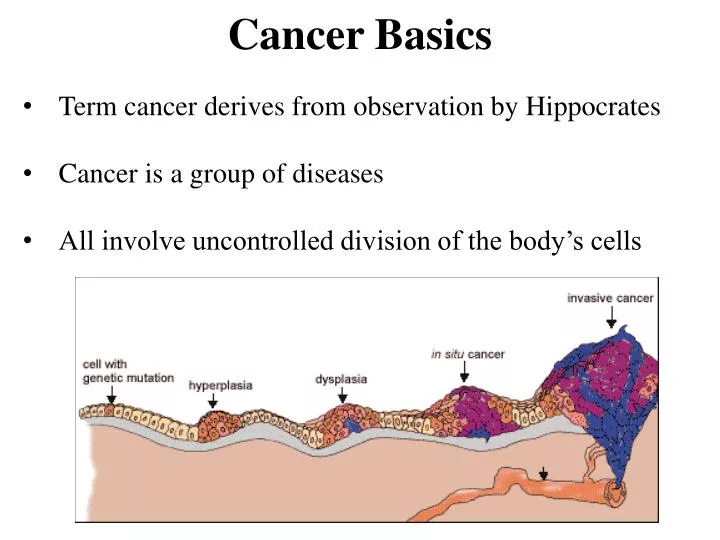Understanding Cancer: A Beginner’s Guide to Definition, Types, and Risk Factors
Share IT

Launch Your Dream Website with Us!
Click Here to Get in touch with Us.
Categories
Cancer Basics
Demystifying the Illness: An Overview of Cancer
Cancer is a difficult and frequently confusing subject. This blog post functions as a starting point by offering a succinct and understandable synopsis of cancer’s various types and the fundamental ideas behind how it progresses.
Thank you for reading this post, don't forget to subscribe!Table of Contents

Cancer is defined as unchecked cell growth.
Cancer Basics
In its most basic form, cancer is defined as a condition with unchecked cell proliferation. Trillions of cells make up our bodies, and each one has a distinct purpose and life span. Cells normally divide in an orderly manner, expand, and finally die.
But this neat procedure goes awry in cancer. Mutations occur in cells’ DNA, which is the genetic code that governs how cells behave. These mutations give cells the go-ahead to divide erratically, creating tumors—abnormal clumps of tissue.
Tumours fall into two primary categories:
Cancer Basics
- Benign tumours: Usually slow-growing, these are not malignant. They don’t spread to other areas of the body, even when their size or location may make them problematic.
- Malignant tumours: These are malignant growths that have the capacity to infiltrate neighbouring tissues and travel (metastasize) via the lymphatic or circulatory systems to distant organs. The disease’s ability to spread metastatically is what makes cancer lethal.
The Various Aspects of Cancer
Cancer Basics
Cancer is actually a group of related diseases, each with distinct features, rather than a single illness:
- Carcinomas: The most prevalent kind of cancer, these grow from the epithelial cells lining the surfaces and organs of the body. Lung cancer, colon cancer, and breast cancer are a few examples.
- Sarcomas: These malignancies originate from tissues that are connected, such as fat, muscle, bone, and cartilage. Soft tissue sarcoma and bone cancer are two examples.
- Leukaemias: These tumours interfere with the creation of healthy blood cells by affecting the bone marrow and blood. Acute lymphoblastic leukaemia (ALL) and chronic myeloid leukaemia (CML) are two examples.
- Lymphomas: These tumours start in the lymphatic system, which is a network of tissues and veins that fights infection. Non-Hodgkin lymphoma and Hodgkin lymphoma are two examples.
Recognising the Cancer Signatures:
Cancer Basics
Scientists have discovered a number of crucial traits, or “hallmarks,” that are shared by the majority of cancers:
- Sustained proliferative signalling: Cancer cells create systems that allow them to communicate constantly in order to promote their own proliferation.
- Avoiding growth suppressors: Healthy cells typically have internal controls that prohibit unchecked development. These safeguards are circumvented by cancerous cells.
- Defying cell death: When a cell is injured or no longer required, it is supposed to die. These processes of normal death are eluded by cancer cells.
- allowing for replicative immortality: Regular cells have a finite lifespan and cease to divide after a predetermined amount of divisions. Cancer cells develop the capacity for endless division.
- causing angiogenesis: In order to proliferate, tumours need a plentiful blood supply. To feed themselves, cancer cells encourage the growth of new blood vessels.
- Turning on invasion and metastasis: Cancer cells acquire the capacity to infiltrate neighbouring tissues and spread to far-off regions of the body.
- Chronic inflammation: can have a role in the development of cancer by encouraging tumours.
- Genome instability and mutation: The aberrant behaviour of cancer cells is fueled by the genetic mutations they accumulate.
- Deregulating cellular metabolism: In order to sustain their quick development and survival, cancer cells modify their metabolism.
- Cancer cells: have the ability to evolve defence mechanisms that prevent the immune system from identifying and eliminating them.
Cancer Basics
Researchers can create more specialised and efficient remedies by comprehending these distinguishing characteristics.
Risk Elements and Preventive Techniques
Cancer Basics
Although the precise causes of cancer are unknown and may involve a number of variables, some known risk factors include:
- Use of tobacco: Smoking increases the risk of developing lung cancer, bladder cancer, and malignancies of the head and neck.
- Diet and exercise: A poor diet heavy in processed foods and red meat, together with inactivity, raises the risk of cancer.
- Obesity: Being overweight raises the chance of developing a number of malignancies.
- Sun exposure: One of the main risk factors for skin cancer is exposure to excessive ultraviolet (UV) radiation from the sun.
- Drinking too much alcohol: Drinking too much alcohol raises the risk of getting malignancies of the mouth, throat, liver, and breast.
- Some bacteria and viruses: Some bacteria and viruses, including hepatitis B and C and the human papillomavirus (HPV), can cause cancer.
- Genetics: Although not all cancers are inherited, certain individuals are more susceptible because of genetic abnormalities they received from their parents.
Cancer Basics
Thankfully, there are lifestyle changes that can dramatically lower the risk of cancer:
Keep your weight in check by eating a well-balanced diet full of whole grains, fruits, and vegetables and getting frequent exercise.

Launch Your Dream Website with Us!
Click Here to Get in touch with Us.





























































Recent Comments